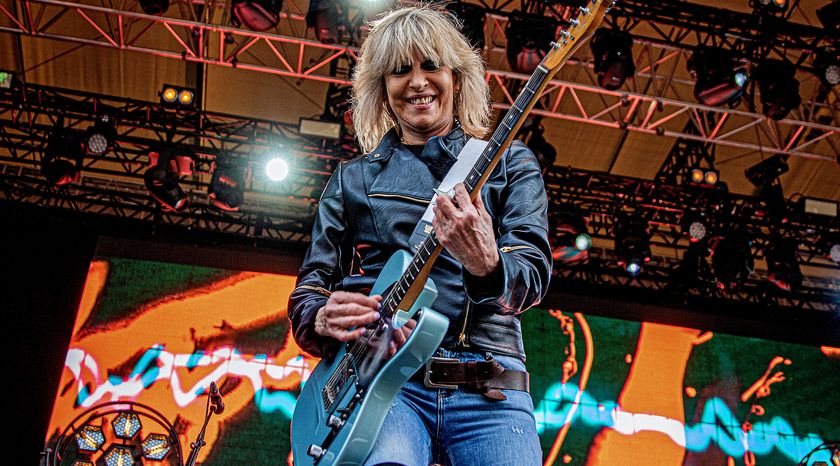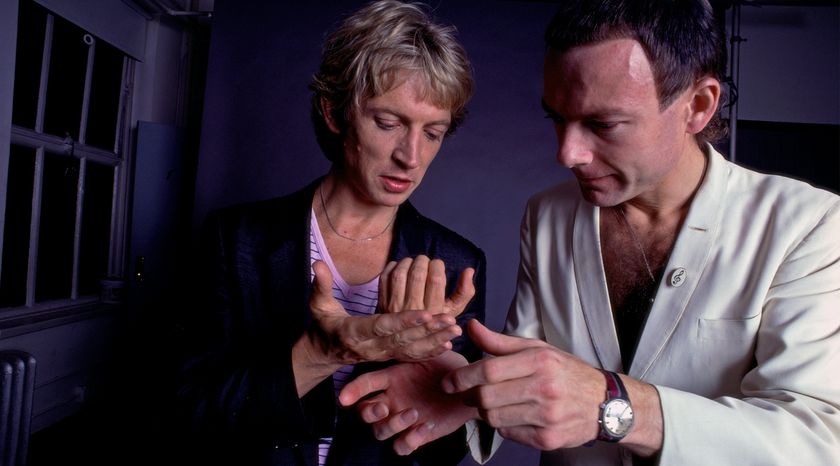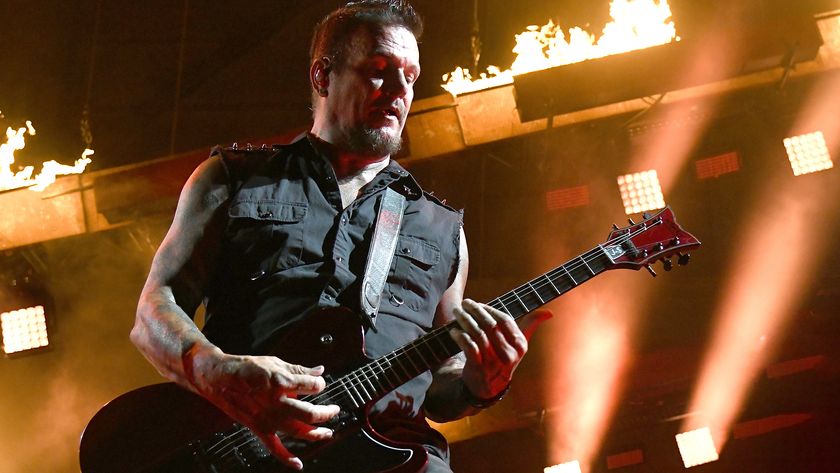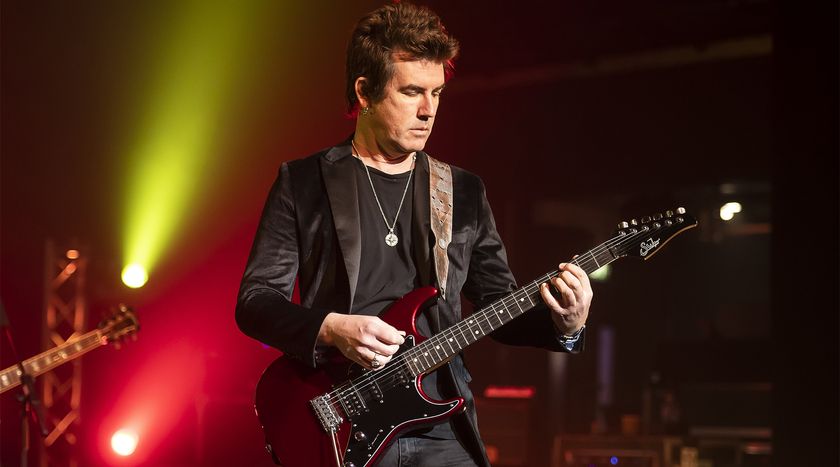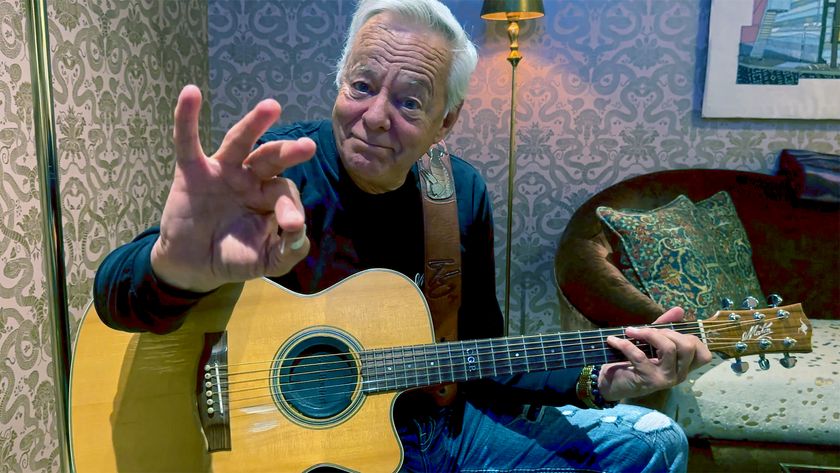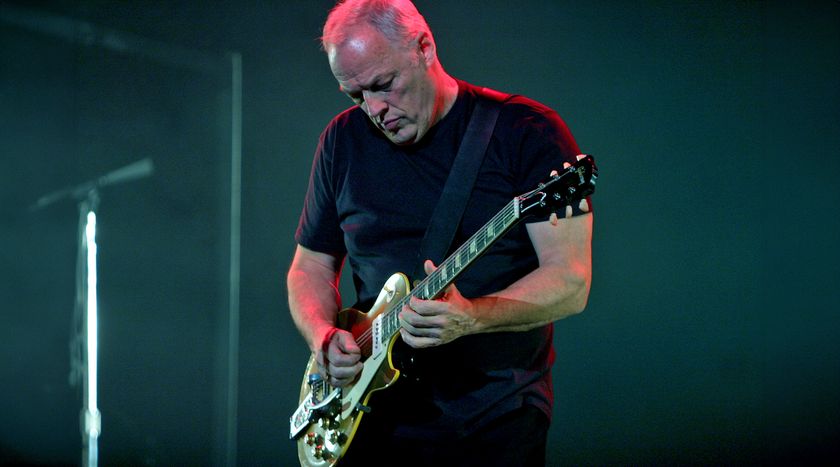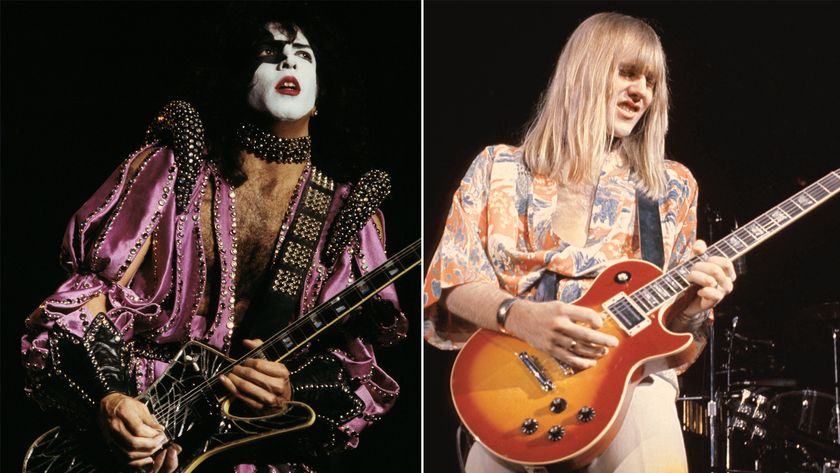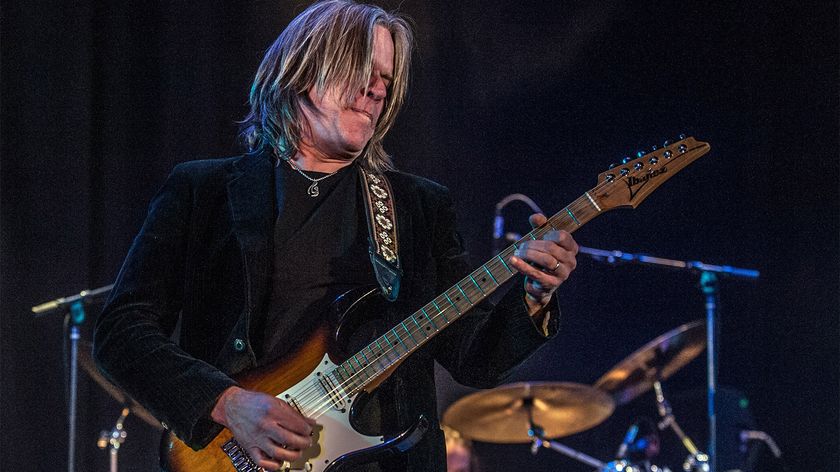“If you're playing with a flatpick full-time, you're only half playing the guitar.” Rory Gallagher delivers a master class in blues in Guitar Player’s 1978 interview
The Irish guitar hero discusses the albums that inspired him, and the gear and techniques that made him one of the all-time greats
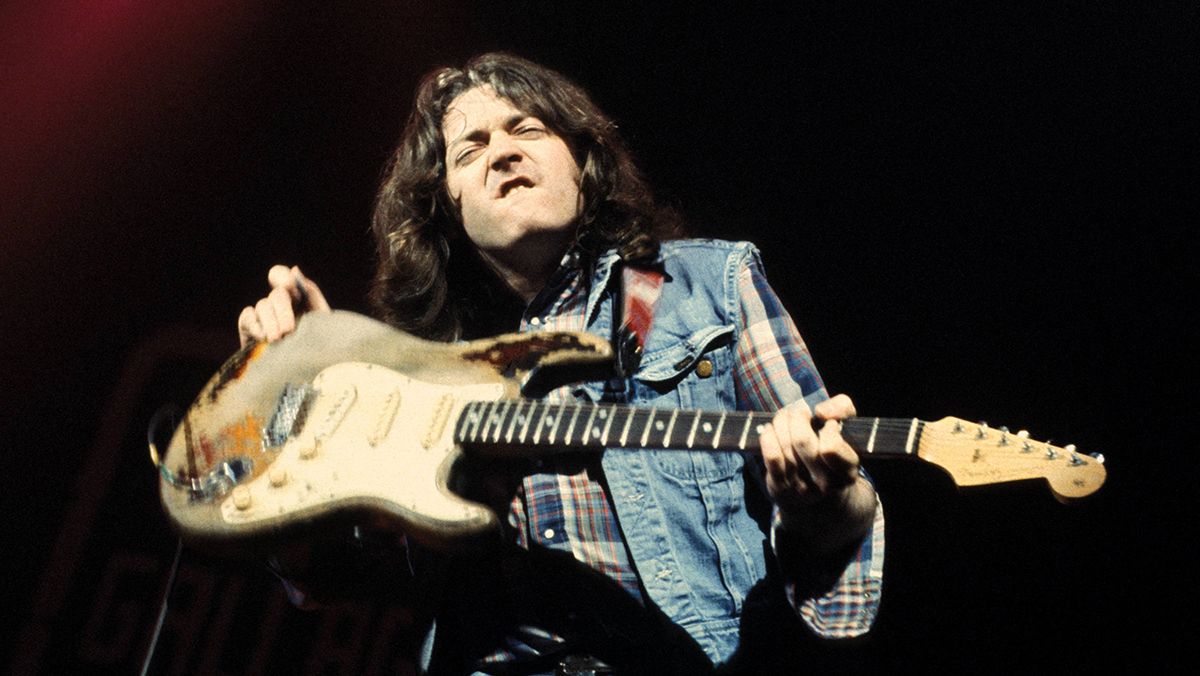
Rory Gallagher was at a crossroads in his career when Guitar Player had the great fortune to speak with him for a cover story in the March 1978 issue. Shortly before it, he’d cut tracks for his followup to 1976’s Calling Card in San Francisco, but was unhappy with the slick sound producer Elliot Mazer gave him.
After catching the Sex Pistols performance in San Francisco on January 14, 1978, Gallagher decided to scrap everything he’d recorded and start over again, producing it himself to have a tougher and more aggressive sound. Unfortunately, soon afterward, he broke his thumb when he caught it in a taxi door, an injury that required months of recovery.
In the meantime, Gallagher began revising his lineup with a goal of returning to the power-trio format of his 1960s group Taste. He fired his keyboardist and replaced his drummer with Ted McKenna. In July 1978, a good four months after this interview hit newsstands, Gallagher, bassist Gerry McAvoy and McKenna went to Dierks Studios, in Cologne, Germany to re-cut the scrapped tracks. The album was released the following October as Photo-Finish, a reference to its hurried completion.
In Stefan Grossman's deep interview with the Irish rocker, we have a veritable master class in blues-rock guitar, Rory Gallagher style. From essential albums to gear — including electric guitars, tube amps, acoustic guitars and accessories such as slides — to picking techniques, it’s all here, and much more.

Blues is said to be a universal experience — as Albert King once preached, "Everybody understands the blues" — and Rory Gallagher is surely a case in point. Born in Ballyshannon, County Donegal, Ireland, the first pieces Rory attempted to play were cowboy songs and Irish folk tunes on acoustic guitar, beginning at age nine. American rock and rollers such as Buddy Holly, Eddie Cochran, Elvis Presley and Chuck Berry had an early impression on Rory, though he discovered blues, à la Leadbelly and Woody Guthrie, by way of Lonnie Donegan's British skiffle hits.
At 15, Gallagher joined the Fontana Show Band, which toured England and Ireland. The constant work helped refine Rory's playing, but the commercial nature of the repertoire caused him to look elsewhere for artistic satisfaction, jamming with the group's drummer and bassist in small clubs throughout Europe.
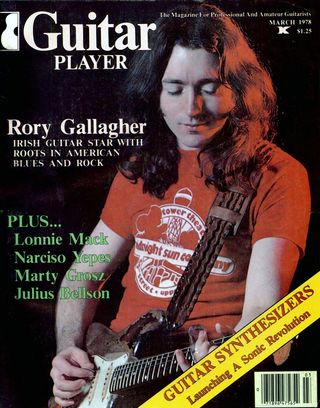
In 1965 Rory formed Taste, the now legendary blues-rock trio, comprised of Eric Kitteringham on bass, Norman Damery on drums, and Gallagher on guitar, vocals, and, occasionally, saxophone. Although the power trio preceded Cream by several years, comparisons with the English supergroup were inevitable.
In 1969, the band signed with Polydor Records, but by 1970, the group had disbanded and Rory pursued a solo career. To date, Gallagher has appeared on over 20 albums, either as leader or sideman, and has graced sessions featuring such notables as Muddy Waters, Jerry Lee Lewi, and Albert King. He gave his first performance as a solo acoustic guitarist at the 1976 Montreaux Jazz Festival in Switzerland. He is currently remixing Photo-Finish, his latest LP for the Chrysalis label, which should be out in early March.
Here, Rory talks about his various musical styles and techniques and the guitars he uses to arrive at his distinctive, energetic sound—an old National Resophonic, a Martin D-35, a Fender Telecaster and his trademark, a battered 1959 Fender Stratocaster.
What Gallagher has to say about blues and rock and roll should be required reading for any aspiring guitarists, just as his many records and live performances should be required listening.
Hypothetically, if you were teaching blues guitar at a school, how would you go about it?
I'd keep it within a reasonably rigid blues framework, just to keep it on center. A lot of it would depend on what music the student had been exposed to. I mean, if your parents were interested in music anyway—your father, for instance, had a couple of Bill Broonzy or Lonnie Johnson albums—or you were brought up listening to jazz programs on the BBC, where they'd slot in the odd blues thing, you'd obviously have a head start. Otherwise, you'd probably get into blues through rock and roll— through Chuck Berry or maybe "High Heeled Sneakers" by Tommy Tucker.
When I'm 40 or 50, I hope I'll have a very distinct sound. When you turn on the radio, you’ll say, ‘That's Rory Gallagher.’”
— Rory Gallagher
Then with the Rolling Stones era, you could sneak into the blues thing that way. In my case, I started on the proverbial Lonnie Donegan skiffle music trail, where I heard Lonnie doing Leadbelly songs, such as "Rock Island Line" and "Bring Me a Li'l Water Silvy." Before I even owned records by Woody Guthrie or Big Bill Broonzy, I used to get library books out in Cork,— because you couldn't buy the albums in Britain — and I'd learn the lyrics to these songs. But at the same time I was interested in rock and roll — such as Buddy Holly, Eddie Cochran, Chuck Berry, and Fats Domino. I was listening to both of these strains, because at lots of points they'd cross.
Once you get beyond the Chuck Berry/Eddie Cochran thing, you begin to figure out that you've got Broonzy at one end of the scale — and that goes right back to the old tradition of Charley Patton — then John Lee Hooker has the Detroit electric blues style, which evolved from his acoustic style. And you also get the Josh White sort of folkie style of blues. You just have to listen to a lot of records.
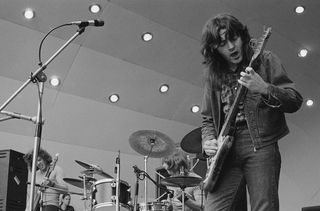
Which records do you think are essential for someone who wants to get into blues?
I suppose you should go out and try to get a good compilation first, like the Paul Oliver selections, The Story of the Blues, Vols. I & II [Columbia] which still have a couple of important people missing; for instance, Muddy Waters isn't on either volume — which is insane. But I suppose you'd have to go back to one of the main sources, say, either Robert Johnson, Lemon Jefferson, Willie McTell or Leadbelly. The two Robert Johnson records on Columbia [King of the Delta Blues Singers, Vols. I & II] are obviously cornerstones. You'd have to get at least one of those. It's pretty hard to zone in on it, because some guys mightn't get into Robert Johnson and might prefer, say, Willie McTell. But if we try to break it down to the key blues albums, I think that either Robert Johnson record would have to be included.
Then Blind Boy Fuller is another favorite of mine, especially that album with Bull City Red and Sonny Terry, with "Pistol Slapper Blues" on it [Blind Boy Fuller (Blues Classics)]. I think that Broonzy album where he does "Banker's Eilues" [The Young Big Bill Broonzy (Yazoo)] is an important one, because he was broadening the scale. It's different from the ones he made around 1950, where it was blues plus ballads. The Best of Muddy Waters [reissued as Sail On (Chess) and as part of Muddy Waters (Chess)] is definitely an archetypal electric blues album.
Do you think albums by people such as Elmore James and Howlin' Wolf are important listening?
Oh yeah. You'd have to get The Real Folk Blues by Wolf, with "Spoonful" and "Shake For Me" [reissued in part on Howlin' Wolf (Chess)] for Hubert Sumlin's electric blues guitar. He's the great undiscovered, underrated lead player. And Wolf himself harks back vocally to Charley Patton, and, besides, he plays a little bit of slide guitar here and there, too — like on "Down in the Bottom." And his harmonica playing is important, even though everyone seems to write it off as just, "He plays harmonica." I think he plays good gut-bucket harmonica.
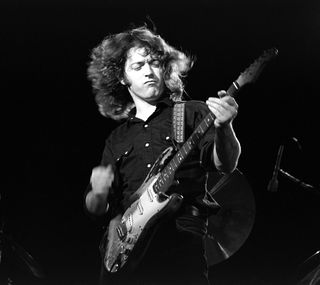
Which of Elmore James's albums would you single out?
It's hard to pin down one album for him, because there are so many oddball ones. I've got one on Ember Records — just sort of a bargain label — and it was reruns of some of his stuff, like "Sunnyland," "Standing at the Crossroads," and "Dust My Broom" yet again. I find that any Elmore James album is good. He played a Kay, I think, with some odd pickup.
For electric slide, Earl Hooker is another favorite of mine. There are three players who use that same famous lick: Earl Hooker used it on "You Shook Me" by Muddy Waters; Muddy uses it all the time; and I think it came from Robert Nighthawk, who did "Sweet Black Angel." He's got a very mellow slide sound, but it's all in standard tuning — nothing's in open tunings.
So let's see: Muddy's important; Elmore James is important; John Lee Hooker; Hubert Sumlin; and the man, Howlin' Wolf. I suppose the best thing to do after you get a couple of compilations is to see which person really turns you on, then try to follow that strain.
What about the older country blues players?
In terms of intensity, Son House has to be listened to. Of all the blues players, that's probably the closest connection with Africa. I've got that one album, with "John the Revelator" [Legendary Father of Folk Blues (Columbia)]. That's an ace album.
If people come to hear you in concert, and they want to learn how to play guitar themselves.
I'm a huge blues fan, but I still have a bit of Eddie Cochran and Buddy Holly hovering around in my head, plus certain folk people, such as Doc Watson."
— Rory Gallagher
Do you think it's more important for them to buy your records or these old records you spoke of?
To learn guitar? Well, I write a lot of my own stuff, so it's a cross between ego and the heritage thing. If you want to play like Rory Gallagher, I think you'd buy my records. But if you want to pick up on whatever echoes of the bluesmen that I respect and love, certainly go ahead and buy some blues records.
In my case, I'd say the obvious influences would be Hubert Sumlin, Earl Hooker and Buddy Guy, electrically. And, acoustically, Blind Boy Fuller and Blind Blake, though I can't get anywhere near what Blake does.
But you see, I never started out to become a strict re-creator of the blues or even a modern young bluesman, as it were. I mean, I wanted to be me. I'm a huge blues fan, but I still have a bit of Eddie Cochran and Buddy Holly hovering around in my head, plus certain folk people, such as Doc Watson — a pretty wide range of listening.
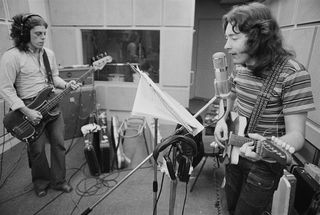
When you're performing, though, don't you consider yourself mainly a blues-oriented musician?
Yes, I do, but I think that I've always strived to forge ahead. At some point, when I'm 40 or 50, I hope I'll have a very distinct sound, as Elmore or Muddy did, so that when you turn on the radio, you’ll say, “That's Rory Gallagher.” It's a thin line between studying the blues and listening to an awful lot of it on one hand, and loving the stuff and doing some blues numbers in your own style on the other hand.
It's hard to break it down into percentages, because some nights we might do something like "Messing With the Kid," a well- known Junior Wells song, or "Bullfrog Blues," or "Rag Mama," the Blind Boy Fuller tune. By the songs I pick to do, you can see the kind of people I like. I like the slightly ragtime-ish blues players, but then again, I like Hooker.
Acoustics
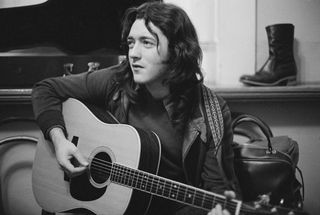
Your changes of style seem to depend in part upon what instrument you are playing. Whereas you seem to lean toward a lot of the acoustic ragtime blues people, when you play electric guitar you go into a completely different area of blues music.
Well, I'm a great fan of all the Kings — the Alberts, the B.B.s and the Freddies. I wouldn't want to say that these people have been overrated, because that would be an absolute insult, but I think they've been recognized to the point where the Earl Hookers and Hubert Sumlins have been underrated. And the guitar player who was with Wolf before Sumlin, Willie Johnson, was a hot player as well.
What type of instrument would you recommend for an acoustic blues novice to start on?
With acoustic guitar, for the first couple of years at least, I think you should leave a wound third string on and really build up strength in the fingers. In other words, don't try bending strings the first week you buy the guitar. Kids are lucky nowadays; you can get a Yamaha or something, and the cheaper model guitars are much better quality than they were years ago when you got this stuff with terrible action.
The first guitar I got cost just over four pounds, which was about 20 dollars then, in the good old days. After a while you get that urge to say, "To hell with this — I'm going to bend this string" instead of sliding up. But you have to build that up.
But do you think a student should start out with, say, a wooden Yamaha or a metal-bodied National such as you sometimes play?
Well, let's put it this way: If you're a kid with ears the size of the moon and an amazing sense of direction, who heard Son House or Blind Boy Fuller or any of the National steel-body players and said, "They're the people I want to play like," then go ahead and buy the National, because that's a great place to start. But if you start with a National, you're talking about a guitar that weighs quite a bit.

Do you find that the National has any technical problems or limitations in terms of sound?
Well, on the one I have, the neck joins the body at the 12th fret, which is unfortunate. I prefer the 14th fret, but I can live with that. You just have to ride over the body with the slide. The action on it isn't bad, and the tuning is good. Obviously, it's loud and banjo-like, and there's only a certain amount of sustain in it, but I think that it slightly dictates what you play.
Could you explain that?
For instance, you don't really bend strings much on a National; you use it more as a straightforward, heavy-playing ragtime guitar, or you play in the Son House bottleneck school.
Do you have any problems miking that guitar onstage, or do you use a contact pickup?
I've tried everything on it. I've tried contact mics, and they just don't work. You have to use the resonator as the microphone. I think Bill Lawrence is making a new pickup that fits onto five-string banjos — you just clamp it onto the end of the neck — so something like that might work. But it's debatable whether you'd be getting a true reproduction of that Resophonic sound. I just put a microphone in front of the resonator and hope for the best.
I use sort of medium-gauge bronze strings — I float around between Earthwood, Darco, Guild, and D'Merle — and you just build up power and volume yourself.
Do you use a wound or an unwound third string on the National?
A wound third, because the numbers I happen to play need that fairly stiff action. I don't do any Broonzy-type bending with light strings on the National, whereas on a Martin acoustic I probably would.

Do you use an acoustic onstage?
I do; I play a Martin D-35. I use the National for things like "Pistol Slapper Blues," which I play faster than Blind Boy Fuller did, and a J. B. Hutto song called "Too Much Alcohol," which he plays electric, of course. There's always the nature of the banjo in the National, I find, and you have to play it sort of like that. I do anyway.
Do you play acoustic with a plectrum or your fingers?
With a plectrum and the fingers. I fool around with National metal fingerpicks and the plastic ones sometimes.
How is your Martin set up?
Well, that's set up with the same strings, because at present I'm doing numbers like Leadbelly's "Out on the Western Plain," where the tuning is D, A, D, G, A, D [low to high]. It's a D tuning, except that the G remains a G.
That's a very English, folk, Baroque tuning à la Bert Jansch and John Renbourn. How do you use that playing the blues?
Yeah, that's right. Well, I'm a fan of that school. "Out on the Western Plain" was always one of my schoolboy favorites, because of the lyrics. I thought, Here's Leadbelly singing a song about cowboys and it didn't seem to be a part of the Black culture. But as it turns out, there were Black cowboys.
So I was fiddling around with slack D, or whatever they call it, and I found that there's an instant unison. If you use a two-fret interval on the second and third strings, you can go up like a dulcimer or a sitar. At any point up the neck, if you hit the second string at a certain fret and hit the third string two frets up, then those notes are the same. You get a kind of raga, dulcimer type of thing.
So it seemed such a nice idea to do the Leadbelly song in that semi-Celtic-cum-whatever style. It's never quite major or minor, so you can do tricks with it.
That particular tuning is from the English folk guitar school, isn't it?
Right. You can stick the Irish in there as well, because I'm sure bagpipe music had something to do with all of that, somewhere along the way. But that was what you could call a happy accident — getting that Celtic, British Isles, Baroque thing clashing with a blues song.
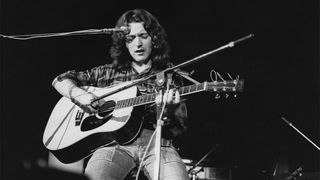
How do you have your Martin miked onstage?
I've got one of those little Ibanez bolt things. I find that the Ibanez has a bit more bite than the Barcus-Berry. If the place is small enough, I skip the pickup and play straight through the house microphone. I prefer to do that, because you can control the volume yourself. And when I use the contact pickup, I use the mike as well, so it's a blend of the two.
By controlling the sound with your hands, do you mean damping the strings?
Pressure on the strings, with your left or right hand. You can move slightly off mic or into the mic. You can just use yourself as a volume control.
How is that sound different from the contact mike?
Well, it's a fairly one-dimensional, compressed sound with a pickup, because, although it's as true as you can get to the natural acoustic sound, I don't think it's exactly there. But I can live with it. Ideally, what I'd like to have is another, lighter f-hole guitar onstage, with light-gauge strings for string-bending styles, but in the present repertoire I don't have any songs for that sort of thing.
What other acoustic things do you do?
I sometimes do this instrumental of my own called "Unmilitary Two-Step” — it's a cakewalk type of thing in C. I find that dreadnoughts need more medium-gauge strings, whereas the OM or f-hole models, the smaller ones, would obviously have to have light-gauge.
Electrics
What do you use for an electric guitar?
I have two different electrics. I have a Stratocaster with Fender light-gauge Rock and Roll strings, which I use for basic playing and some slide work in straight tuning. I also have a Telecaster for A tuning and other open tunings, for songs like "Bullfrog Blues."
Why the Stratocaster?
Well, that's the eternal argument among Fender fans. Buddy Holly had a Strat, and as a child you go after the appearance of a guitar; I don't care what anyone says. You look at the shape of the thing, and that's it. I've tried Gibsons, but I'm not a great fan of humbucking pickups.
Why is that?
Because as you bring down the volume from 10 to nine to eight, after that — forget it. The guitar loses its sensitivity and drive. Whereas with the single-coil or P-90 pickups — one of the old Gibson units with the black or white plastic covers — the volume control goes down nice and gradually, and even at six the guitar is still doing something.
I like a good bright tone, and I like the out-of-phase sound you can get with the switch set between the normal positions on a Strat. It's comfortable, the scale seems right, and I like having the machine heads on one side — it just seems to make sense. But if you want, say, a more luxurious, fatter sound, the Gibson guitar certainly would do the job, and it's got an extra fret — if anybody ever touches that fret; I'm sure they don't.
Is your Strat modified in any way?
It's practically straight off the rack. The only modification is that the tone control for the middle pickup is now a master volume control, because over the years I've found that when you jump from the middle pickup to the lead, or treble, pickup you couldn't adjust it.
Why do you usually switch to the Telecaster for slide?
I thought it had a certain steel-guitar type of tone which would work well with slide, but I was frustrated with the rhythm pickup — I thought it was too thin. So I put a Strat pickup there, and it remained that way for a year. Then I said, "To hell with it — I'll do the Telecaster à la Strat," so now I've got two Strat pickups and a Tele lead pickup and a five-way Strat toggle switch. It's like the best of both worlds with the Telecaster lead pickup, which is slightly hotter than a Stratocaster's.
Is it strung the same as the Stratocaster?
No, it's kind of a blend; it's more like medium-gauge. I have something like an .013 for the first, then .015, an unwound .018, and so on. On the Strat, it's as they come out of the packet — I think it's .010, .012, .015, .026, .032, .038. That seems to be about the most balanced set I could find. I would prefer something like an .040 on the bottom — which I sometimes stick on if I have it handy—because I think the bottom end is a little too light for me.
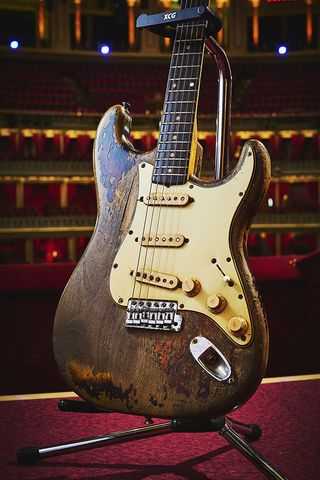
Is the action higher on the Telecaster for the slide work?
The action on the Strat is quite high as well. I like high action, like on an acoustic. The heavier-gauge strings on the Telecaster are a bit more taut anyway, so I don't have to raise the bridge. You can play not only slide, but regular guitar on it.
What do you use for a slide?
It depends; I shift around. I sometimes use a bottleneck on my ring finger for electric stuff. Otherwise I've got two stainless steel tubes, which I sometimes use on my small finger or the ring finger. They get a more stinging, Muddy Waters sound. You get a different sound depending on what slide you use. For instance, if you're playing slide on a National with a glass slide, forget it. You have to have something like steel or, even better, copper. Son House used copper, and I've got one of those as well.
Were these slides store-bought items, or did you just go to a hardware shop?
I went to a hardware shop and got the proverbial bit of piping chopped up and got a Brillo pad out and shone it up. There's a bit of surface noise there, but Son House has that sound; it's best, because it clings to the strings. I used to use copper on electric as well, but I found that the stainless steel was a pretty good compromise between the copper or bronze and the glass. Glass is nice, because it works a little more like a Hawaiian or lap steel guitar. It's sweeter and softer. I change my mind every couple of gigs.
With four guitars onstage—the Strat, the Tele, the Martin, and the National—is it difficult to adapt from one to another in terms of each instrument's feel?
I think you probably do it subconsciously if you play an awful lot. It never troubles me particularly; I just get ready for it. I know it's going to be slightly heavier strings or whatever.
For instance, on the National the neck joins the body at the 12th fret, but even though you have medium strings, you might be in D tuning, which is kind of slack anyway, so you're not called upon to bend the string up two tones or something. The only thing that throws me is moving from plectrum and fingers, which I use on the electric, to the thumbpick and fingerpicks. After doing, say, an hour of electric stuff, then switching to acoustic and putting on fingerpicks, I can't quite do it. If I were playing a straight folk club gig, I could probably manage it. When I'm playing around at home I just use my bare fingers, even on electric. Just the thumb and first finger, because that's another sound as well. There's a different arch involved in the hand.
Once in a blue moon all the odd tunings throw me, but I'm crazy about tunings. There's a lot that can still be done there. In the rock and roll field I don't think that that's been truly tapped yet.
Playing rock and roll in open tunings?
Well, not so much open tunings, but the odd tunings like DADGAD, or that kind of Celtic one Davy Graham was using — E A D E A E. It’s another bagpipe one.
Amplification
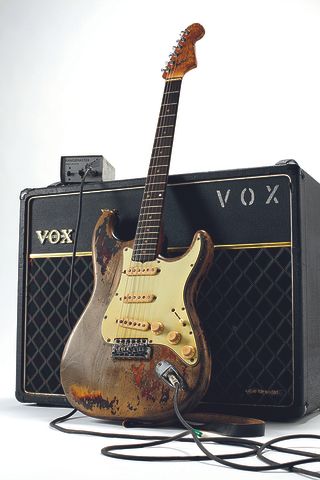
What type of amplification do you use?
For years I used a Vox AC-30, which is the best all-around European amp I've ever come across. I still have it. The Shadows used to use them and the Beatles used them, so you know it was the popular amp. But I found that when using the treble booster, if I used the normal input — which was very bassy, as opposed to the brilliant input — I could get that nice rough edge without getting into a very fuzzy sound. I used that for years, and I've had odds and sods in between, but then I moved on to an old ’50s tweed Fender Twin, which I still have. Then I got into a tweed Fender Bassman, and recently I got a Fender Concert, which is an old brown one, from around 1959, with four 10-inch”speakers. I use a Hawk booster through that just to roughen it up a bit, or if it's a quiet number I plug straight in and keep the guitar clean sounding.
Do you feel that the old Fender amps are better than the newer Fenders?
They seem to warm up sooner. They wouldn't have the wide tonal range that the new Fenders have — particularly the new Fender Super Twin, which has a graphic equalizer, a master volume control, overdrive, and all that — but I probably have some interest in old amps over and above the actual music because of their appearance and because the guys in the ’50s used them. But I do find that they really have an atmospheric sound.
I've never been a fan of the hundred-watt stacks; that just hasn't appealed to me. I always like a Twin or a 4x10 speaker setup. And some of those hundred-watt stacks really only give you about 50 watts, while an AC-30 is a genuine 30 watts. Instead of a wall of sound, where you lose your song because it's spread out among eight speakers, I'd rather see a small amp turned to eight or nine and really hopping off the chair.
Do you use the same setup in the studio?
Yes, same thing, plus I have an old Magnatone, which went out through Sears-Roebuck in the States. Generally, I end up using the AC-30 or one of the old Fenders. I like to do lead parts live, so you obviously have to have an amp that will be fairly loud, so the other guys in the studio can hear you.
Picking vs. Fingers
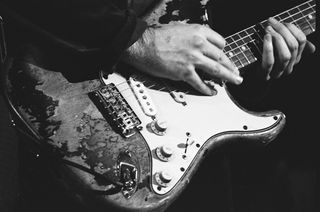
Do you think it's advantageous to learn acoustic before moving on to electric?
Well, I played acoustic for two or three years before I bought an electric. I wasn't particularly interested in electric for the first couple of years, because I was a Lonnie Donegan fan. I think it's better to start on acoustic and then get into electric, but you could get into a fistfight over that. I mean, some people would say, "To hell with acoustic guitar; it never existed. You've got to get a solidbody right away." Fair enough, but I think they're missing out.
Even if you're going to become the consummate 1978 electric guitarist, I think you're missing out on an awful lot, if only for the fun of playing an acoustic guitar at home as a hobby. And it's nice to go from the acoustic, where even at the best of times the action is fairly taut, to the electric with light strings, where you float around like jelly. If you're always playing on light- gauge strings, you'll never really build up strength and subsequently real volume without turning up your amp yet again.
Are there any other techniques that you can adapt from acoustic to electric?
If you never played acoustic the odds would probably be three-to-one that you might never get into, say, playing with a plectrum and fingers or ever get interested in the various acoustic right-hand things. I think if you're just playing with a flatpick full-time, you're only half playing the guitar.
When you use both the flatpick and your fingers, are you fingerpicking with the middle and ring fingers?
Yes, sort of a James Burton type of thing. Obviously, if you're just chopping chords you don't use the fingers. Sometimes you might do the little harmonic tricks where you clip the string and get a squeal, but if you want to get a jingly-jangly thing, use your fingers.
Where did you pick that up?
I began playing just straightforward plectrum style, but as things went along it just seemed to fall into place. Besides I played in some dance bands and show bands in Ireland, where as often as not we didn't have a rhythm guitarist, so you'd play the rhythm part as well as the lead. Say you were doing a Shadows song — they were like the English Ventures — you'd have to fit in the melody and a form of rhythm. That's probably where I got it from, plus Ricky Nelson records with James Burton on guitar. He was obviously using his thumb and fingers or a pick and fingers.
So would you advise learning to fingerpick with bare fingers, with fingerpicks, or with a plectrum and the fingers?
Well, if you could wave a magic wand, you should tell the person to try all forms and be familiar with them all — anything instead of just using the plectrum alone. I think at some point in every song you're going to need the fingers. If you're interested in classical guitar, it's nice to get a couple of years training at that, and then you'd have very strong hands, and you could skip thumb picks and metal picks or whatever.
Do you use fingerpicks mainly for volume, or do you use them for a specific sound?
I would use them for volume, you know, and to save wear and tear. If I were a highly developed thumb-and-fingers person I'd just use the bare skin, but you do get the real sharp, biting sound with the metal claws. Gary Davis just used the one plastic fingerpick, and he seemed to make great sense out of that.
Do you see any advantage to the plectrum and fingers over thumbpick and fingerpicks?
The advantage of the plectrum and fingers is that you can forget about the fingers at certain points where, say, you're doing a Buddy Holly number or an Eddie Cochran thing or a modern blues, where the fingers don't really come in, where you really have to sledgehammer the guitar. If you were trying to play a rock and roll or electric blues thing, fingerpicks might become a little bit cumbersome — although they never seemed to get in Freddie King's way. He only used the thumbpick and one metal fingerpick, which surprised me.
Then there's an English guitarist, Tony McPhee, who plays with the thumb and one finger. I think John Hammond does it as well, although he picks, too. Johnny Winter plays with a thumbpick and his bare finger, kind of like Muddy Waters, although Muddy uses a pick on his index finger. Let's put it this way: If you want to play a lot of electric blues or electric blues-cum- rock or whatever, the plectrum plus the fingers is probably the best common denominator. Then acoustically you can imitate the Doc Watson style. But to be true to the old ethnic folk and blues traditions I guess you really should be at least familiar with using your thumb and fingers, because there are certain numbers where the plectrum is a hindrance.
Would a plectrum be a hindrance when you're slapping the string on some tunes?
I can get away with that, oddly enough, but that depends on how difficult the piece is. For instance, I don't think you could do a Blind Blake piece with plectrum and fingers, but you'd at least manage a version of it. It depends on how true to the old version you're trying to get. Maybe you're just playing it for fun; maybe you're doing it for very aesthetic reasons.
Most young guitar players nowadays, even if they've only been listening to people like the Beatles, must know that they couldn't do all those things with just a plectrum. Even like "Dear Prudence" on the Beatles' White Album — that's a D tuning or something, and Lennon is playing with his fingers. He's always been quite fond of that.
So you think it's very important for a student to learn to use fingers as well as a pick?
Yeah, even if he never touches folk or blues music. Of course, the sky's the limit nowadays, and I suppose for Chuck Berry rock and roll it doesn't matter too much, but even Keith Richard uses his fingers on things like "Honky Tonk Woman."
Effects

Do you use any effects devices?
Well, there are a million and one pedals around, and I have a phase shifter I use once in a blue moon in the studio, but I think that's been sort of overused. My favorite of all the gimmicks is the vibrato or tremolo — that old Bo Diddley sound. That's fantastic with distortion, because it really plays tricks with the rhythm and it foxes the player. I like to overdrive the amp, as opposed to using a fuzz box.
Better still, get a dirty Fender Champ and play the lead on that through a bigger amp. And I still prefer to get a wah-wah effect by working the guitar's tone control manually. I think it's more fun, and that's where the Fender guitar comes in and has a slight advantage over most Gibsons. Most Gibsons have two volume controls and two tone controls, and they're too far away to reach, and that's a bit of a drag. The Strat is ideal, because you can get the crying sound with the volume and tone controls.
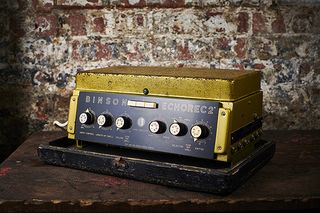
Guitar Essentials
Do you think it's important for a guitarist to learn to read music?
I did it by ear, listening to records. I never had a teacher, and I regret that I can't read music. I went into the library once and got Teach Yourself How io Read Music or something, and it said, "Sit down at your piano." We didn't have a piano, so that went down the chute. Then I worked out F, A and C and gave up, because I was too impulsive, and I was already delighted that I could play "Lost John" and a couple of other songs.
Then, next thing, I was playing blues and rock and roll, which is fairly instinctive and primitive stuff anyway. But later on you start getting beyond the open tunings and ragtime blues, you know, and you're listening to someone like Django Reinhardt or modern jazz guitarists, even bossa nova stuff like Charlie Byrd, and you begin to feel a little inadequate if you're an all-around guitar fan. So you get a couple of books on chords and try to make sense of that. That's where the reading would probably come in. It would help if you were a bit of a jazz fan.
The best all-around thing is a ragtime piece or a classical piece. Even if you're the hammiest classical player in the world — which I am — it's very good exercise."
— Rory Gallagher
When recording with other musicians, do you find that not knowing written, music limits your ability to communicate ideas in the studio?
No, that's no problem, because you can hum it to them or play it on the guitar. I don't think that's the drawback. The only drawback is if you were interested in playing a classical piece verbatim, or you wanted to play a Charlie Christian solo and really wanted to find out all the notes that he played and the harmony and theory thing behind it. Sometimes you say, "To hell with it; it doesn't matter anyway," but it kind of does matter. I'd say a year or two of just learning a little bit of theory wouldn't do any harm. Even tablature foxes me; I have no head for mathematics.
What advice could you give in terms of practicing the guitar?
Well, it's like the old cliche: You have to love the instrument and the idea of the instrument and the whole aura of the thing, and that will dictate how much you practice, really. I don't think you have to sit down for eight hours a day or anything, but if you're really interested you'll probably do that anyway in the early stages — and even after that, between trying to write songs and experimenting with notes and loosening your fingers. I think you're bound to get in an hour or two a day anyway, although some guys say they only play five minutes a day outside the gig.

Do you find yourself playing a lot during the day?
Quite a lot, yeah, in fits and starts. If I have a complete day off I play a bit after breakfast, for lateen minutes or so, to begin with.
Are there any specific exercises you play?
Nothing specific, no. I just try to get the old muscles loosened. Sometimes I'm working on a song, or I might play along with a record for the hell of it. You try not to be lazy; you try to do something that's a step ahead. The best all-around thing is a ragtime piece or a classical piece. Even if you're the hammiest classical player in the world — which I am — it's very good exercise.
On acoustic guitar?
On acoustic, yeah. Of course, on electric this is where the famous fingers-and-plectrum come in. See, if you're playing electric guitar on your own, and the guys in the band aren't around, it's very hard to just play notes. You're bound to start sticking in a chord and keeping the A string going while you're doing a bit of lead. It seems inevitable, you know.
Could you offer any advice for guitarists wanting to become professionals?
If you wanted to get into, say, electric blues, I'd get into a band as soon as possible, no matter how bad it is. Don't be too proud — get into some kind of band; get playing with a drummer. That's essential for electric blues. If you want to play acoustic music on your own, just hurry up and get a gig if you can. Get out there and play in front of people.
But you shouldn't get too clogged up with the old stuff to the point where you won't be moving on yourself, because you won't end up like an old master yourself."
— Rory Gallagher
You feel that playing in front of people is an important thing to do as soon as possible?
Yes, it brings something out. I know for a fact that if I'm off the road for a long spell, even if I'm rehearsing like mad and playing a lot at home, the real crunch comes when I get out in front of people. The things you thought were really hot in rehearsal don't make any sense, because quite often you've forgotten the basic drive.
In rehearsals sometimes the basics get glossed over, because you're fooling around too much with the frilly stuff. If you get out there in front of an audience, drop your pick or break a string, that toughens you up, and it brings out projection in your playing. You have to direct your playing somewhere — unless you want to sit in a room like the painter looking at the painting he's just done, and he won't show it to anybody.
You do get people like that, who think there's no one in the city who's good enough to play with. But even acoustic players should get to a folk club and listen to other people, play with other people. There's always a thin line between studying the old records by the old masters and trying to develop yourself. I think both can be done at the same time, because if you forget the old masters you miss out on a whole heritage and a whole world, really.
But you shouldn't get too clogged up with the old stuff to the point where you won't be moving on yourself, because you won't end up like an old master yourself anyway, you know?
Get The Pick Newsletter
All the latest guitar news, interviews, lessons, reviews, deals and more, direct to your inbox!
